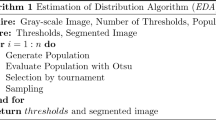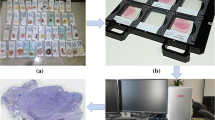Abstract
Automated separation and classification of touching or overlapping chromosomes in a metaphase image is a critical step in computer-aided chromosome analysis. The advent of the multiplex fluorescence in situ hybridization (M-FISH) technology enables multi-spectral chromosome image with rich spectral information and DAPI image with abundant texture information. This paper presents a fusion classification scheme to improve the segmentation of overlapping and touching chromosomes. First, the texture and spectral information is fused to partition the chromosome cluster into a series of homologous regions. Then a graph-theoretical classification and pairing method is proposed to resolve any remaining ambiguity of the aforementioned separation process. Experiment results demonstrate that the proposed method outperforms conventional multi-spectral classification methods in touching and overlapping chromosome separation.






Similar content being viewed by others
References
Agam G, Dinstein IH (1997) Geometric separation of partially overlapping nonrigid objects applied to automatic chromosome classification. IEEE Trans Pattern Anal Mach Intell 19(11):1212–1222
Maierrhofer C, Jentsch I, Lederer G et al (2002) “Multicolor FISH in two and three Dimensions for Clastogenic Analysis”. Mutagenesis 17(6):523–527
Lee C, Gisselsson D, Jin C et al (2001) Limitations of chromosome classification by multicolor karyotyping. Am J Hum Genet 68(4):1043–1047
Schwartzkopf WC, Bovik AC, Evans BL (2005) Maximum likelihood techniques for joint segmentation-classification of multi-spectral chromosome images. IEEE Trans Med Imaging 24(12):1593–1610
Biyani P, Wu X, Sinha A (2005) Joint classification and pairing of human chromosomes. IEEE Trans Computational Biol Bioinfo 2(2):102–109
Lerner B (1998) Toward a completely automatic neural-network-based human chromosome analysis. IEEE Trans Trans Syst Man Cybern Part B, 28(4): 544–552
Stanley RJ, Keller JM, Gader P, Caldwell CW (1998) Data-driven homologue matching for chromosome identification. IEEE Trans Med Imaging 17(3):451–462
Carothers A, Piper J (1994) Computer-aided classification of human chromosomes: a review. Stat Comp 4(3):161–171
Ji L (1994) Fully automatic chromosome segmentation. Cytometry 17:196–208
Wang Y, Castleman KR (2005) Normalization of multicolor fluorescence in situ hybridization (M-FISH) images for improving color karyotyping. Cytometry 64:101–109
Garini Y, Gil A, Bar-Am I et al (1999) Signal to noise analysis of multiple color fluorescence imaging microscopy. Cytometry 35:214–226
Gariniy Y, Macvillez M, Manoir S et al (1996) Spectral karyotyping. Bioimaging 4:65–72
Choi H, Bovik AC, Castleman KR (2006) Maximum-likelihood decomposition of overlapping and touching M-FISH chromosomes using geometry, size and color information. In: Proceedings of the 28th IEEE EMBS annual international conference, pp 3130–3133
Grisan E, Poletti E, Ruggeri A (2009) Automatic segmentation and disentangling of chromosomes in Q-Band prometaphase images. IEEE Trans Info Technol Biomed 13(4):575–581
Karvelis PS, Fotiadis DI (2008) A region based decorrelation stretching method: application to multispectral chromosome classification. In: 15th IEEE international conference on image processing, pp 1456–1459
Sampat MP, Bovik AC, Aggarwal JK et al (2005) Supervised parameter and non-parameteric classification of chromosome images. Pattern Recogn 38:1209–1223
Popescu M, Gader P, Keller J et al (1999) Automatic karyotyping of metaphase cells with overlapping chromosomes. Comput Biol Med 29(1):61–82
Wu X, Biyani P, Dumitrescu S (2004) Globally optimal classification and pairing of human chromosomes. In: Proceedings of the 26th annual international conference of the IEEE EMBS. pp 2789–2792
Shah S (2005) Multispectral integration for segmentation of chromosome images. CAIP 2005, LNCS 3691, pp 506–513
Karvelis PS, Tzallas AT, Fotiadis DI et al (2008) A multichannel watershed-based segmentation method for multispectral chromosome classification. IEEE Trans Med Imaging 27(5):697–708
Otsu N (1979) A threshold selection method from gray-level histograms. IEEE Trans. Trans. Syst Man Cybern 9(1):62–66
Sund T, Eilertsen K (2003) An algorithm for fast adaptive image binarization with applications in radiotherapy imaging. IEEE Trans Med Imaging 22(1):22–28
Trier OD, Taxt TM (1995) Evaluation of binarization methods for document images. IEEE Trans Pattern Anal Mach Intell 17(3):312–315
Cai W, Chen S, Zhang D (2007) Fast and robust fuzzy c-means clustering algorithms incorporating local information for image segmentation. Pattern Recogn 40(3):825–838
Ali M, Dooley L Karmakar G (2005) Fuzzy image segmentation combing ring and elliptic shaped clustering algorithms. In: International conference on information technology: coding and computing (ITCC’05), vol 2, pp 118–122
Almohamad H, Duffuaa S (1993) A linear programming approach for the weighted graph matching problem. IEEE Trans Pattern Anal Mach Intell 15(5):522–525
William G, Tarjan R, Tsioutsiouliklis K (2004) Graph clustering and minimum cut trees. Internet Math 1(4):385–408
Choi H, Castleman KR, Bovik AC (2006) Segmentation and fuzzy-logic classification of M-FISH. In: 2006 IEEE international conference on image processing, pp 69–72
Ramanath R, Snyder WE, Qi H (2003) Eigenviews for object recognition in multispectral imaging systems. In: Proceedings of the 32nd applied imagery pattern recognition workshop (AIPR’03), pp 2003
Lu Y, Morris J, Edwards P, Shipley J (2000) Evaluation of 24-color multifluor-fluorescence in situ hybridization (M-FISH) karyotyping by comparison with reverse chromosome painting of the human breast cancer cell line T-47D. Chromosome Res 8:127–132
Acknowledgments
This work was supported by the Natural Science Foundation of China under Grants No. 61071172, 60602056 and 60634030, Aviation Science Funds 20105153022, Sciences Foundation of Northwestern Polytechnical University No. JC200941 and No. JC201251, and the China Scholarship Council.
Author information
Authors and Affiliations
Corresponding author
Rights and permissions
About this article
Cite this article
Zhao, Y., Kong, S.G. Automated classification of touching or overlapping M-FISH chromosomes by region fusion and homolog pairing. Pattern Anal Applic 16, 31–39 (2013). https://doi.org/10.1007/s10044-012-0301-y
Received:
Accepted:
Published:
Issue Date:
DOI: https://doi.org/10.1007/s10044-012-0301-y




